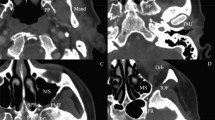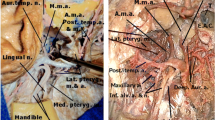Abstract
Purpose
The pterygomeningeal (accessory meningeal) artery arises from the middle meningeal or maxillary artery. Although there is the potential that this artery may be wounded by the surgery for the temporomandibular joint disorder, the current state of anatomical knowledge is insufficient. This study investigated the appearance and the branching pattern of this artery as a means to its characterization.
Methods
The pterygomeningeal artery was dissected in 14 cadavers and its branches and their distributions to the muscles inside the mandible were examined.
Results
The maxillary artery passed lateral to the lateral pterygoid muscle. The pterygomeningeal artery arose from the middle meningeal or maxillary artery. It ascended anteriorly and coursed medial or lateral to the mandibular nerve. It passed above the pterygospinous ligament and then descended. The ascending trunk gave some lateral branches to the lateral pterygoid muscle. The branches sometimes passed lateral to the mandibular nerve even if the pterygomeningeal artery coursed medial. The descending trunk was divided into middle and medial branches, which supplied the medial pterygoid muscle and the tensor veli palatini, respectively. The pterygomeningeal artery was sometimes equally bifurcate near the origin, and the counterparts passed lateral and medial to the mandibular nerve. The distributions of the medial and lateral counterparts were equivalent to those of the descending trunk and the lateral branches, respectively.
Conclusion
The pterygomeningeal artery contains three groups of muscular branches, which sometimes appear in a bifurcate form. Their positions relative to the mandibular nerve and the pterygospinous ligament characterize the artery; this information may help to avoid iatrogenic injury.



Similar content being viewed by others
Availability of data and material
Not applicable.
Code availability
Not applicable.
References
Adachi B (1928) Das Arteriensystem der Japaner. Kenkyusha. Kyoto, Tokyo
Baumel JJ, Beard DY (1961) The accessory meningeal artery of man. J Anat 95:386–402
Bergman RA, Thompson SA, Afifi AK, Saadeh FA (1988) Compendium of human anatomic variation: text, atlas, and world literature. Urban & Schwarzenberg, Baltimore, Munich
Bonasia S, Smajda S, Ciccio G, Robert T (2020) Middle meningeal artery: anatomy and variations. AJNR Am J Neuroradiol 41:1777–1785
Bracco S, Bertelli E (2021) Accessory middle meningeal artery or anastomosis between the ophthalmic and the middle meningeal arteries? On the correct way to make a proper identification. Surg Radiol Anat 43:1309–1310
Bradley M, Patten AM (1953) The cardiovascular system. In: Schaeffer JP (ed) Morris’ Human Anatomy, 11th edn. The Blakiston Company, New York, Toronto, pp 611–828
Dennison J, Batra A, Herbison P (2009) The maxillary artery and the lateral pterygoid muscle: the New Zealand story. Oral Surg Oral Med Oral Pathol Oral Radiol Endod 108:e26-29
FIPAT (Federative International Programme on Anatomical Terminologies) (1998) Terminologia anatomica. international anatomical terminology, 2nd edn. Georg Thieme Verlag, Stuttgart, New York
Hussain A, Binahmed A, Karim A, Sándor GK (2008) Relationship of the maxillary artery and lateral pterygoid muscle in a caucasian sample. Oral Surg Oral Med Oral Pathol Oral Radiol Endod 105:32–36
Katsnelson A, Markiewicz MR, Keith DA, Dodson TB (2012) Operative management of temporomandibular joint ankylosis: a systematic review and meta-analysis. J Oral Maxillofac Surg 70:531–536
Kim JK, Cho JH, Lee YJ, Kim CH, Bae JH, Lee JG, Yoon JH (2010) Anatomical variability of the maxillary artery: findings from 100 Asian cadaveric dissections. Arch Otolaryngol Head Neck Surg 136:813–818
Kwak HH, Hu KS, Hur MS, Won SY, Kim GC, Park BS, Kim HJ (2008) Clinical implications of the topography of the arteries supplying the medial pterygoid muscle. J Craniofac Surg 19:795–799
Lasjaunias P, Théron J (1976) Radiographic anatomy of the accessory meningeal artery. Radiology 121:99–104
Maiuri F, Donzelli R, de Divitiis O, Fusco M, Briganti F (1998) Anomalous meningeal branches of the ophthalmic artery feeding meningiomas of the brain convexity. Surg Radiol Anat 20:279–284
Sashi R, Tomura N, Hashimoto M, Kobayashi M, Watarai J (1996) Angiographic anatomy of the first and second segments of the maxillary artery. Radiat Med 14:133–138
Schönegg D, Ferrari R, Ebner J, Blumer M, Lanzer M, Gander T (2021) Proximity of the middle meningeal artery and maxillary artery to the mandibular head and mandibular neck as revealed by three-dimensional time-of-flight magnetic resonance angiography. Oral Maxillofac Surg Online ahead of print
Standring S (2005). Head and Neck. In: Standring S, Ellis H, Healy JC, Johnson D, Williams A (eds) Gray’s anatomy, 39th edn. Elsevier Churchill Livingstone, Edinburgh, London, New York, Oxford, Philadelphia St Louis, Sydney, Toronto, pp 439–723
Thane GD (1894) Myology; angeiology. In: Schäfer EA, Thane GD (eds) Quain’s elements of anatomy, vol 2, part 2, 10th edn. Longman Green and Co, London, New York, pp 199–350; 351–356
Tunali S (2016) External carotid artery. In: Tubbs RS, Shoja MM, Loukas M, editors. Bergman’s comprehensive encyclopedia of human anatomic variation. Wiley Blackwell, Hoboken, pp 477–486
Vitek JJ (1989) Accessory meningeal artery: an anatomic misnomer. AJNR Am J Neuroradiol 10:569–573
Walles EW (1972) The blood vascular and lymphatic systems. In: Romanes GJ (ed) Cunningham’s textbook of anatomy, 11th edn. Oxford University Press, London, pp 837–967
Acknowledgements
The authors sincerely thank those who donated their bodies to science so that anatomical research could be performed. Results from such research can potentially increase mankind's overall knowledge that can then improve patient care. Therefore, these donors and their families deserve our highest gratitude.
Funding
No funds, grants, or other support was received.
Author information
Authors and Affiliations
Contributions
The author contributed to the study conception and design, this is completely the author’s own work, and the author approved the final manuscript.
Corresponding author
Ethics declarations
Conflict of interest
The author has no conflicts of interest to declare that are relevant to the content of this article.
Additional information
Publisher's Note
Springer Nature remains neutral with regard to jurisdictional claims in published maps and institutional affiliations.
Rights and permissions
About this article
Cite this article
Sakamoto, Y. Characterization of the pterygomeningeal artery based on branching pattern and muscular distribution. Surg Radiol Anat 44, 543–550 (2022). https://doi.org/10.1007/s00276-022-02911-0
Received:
Accepted:
Published:
Issue Date:
DOI: https://doi.org/10.1007/s00276-022-02911-0




